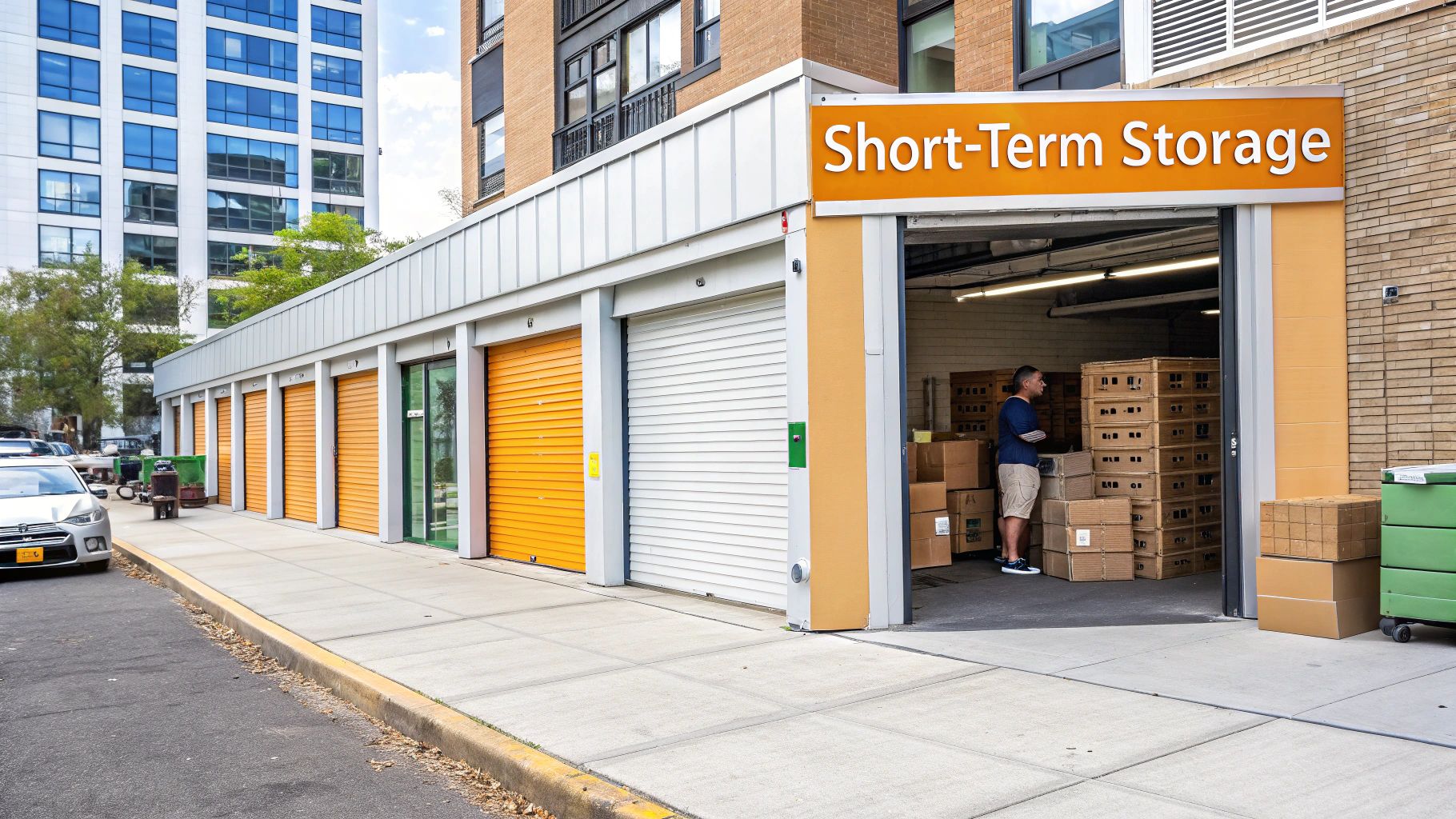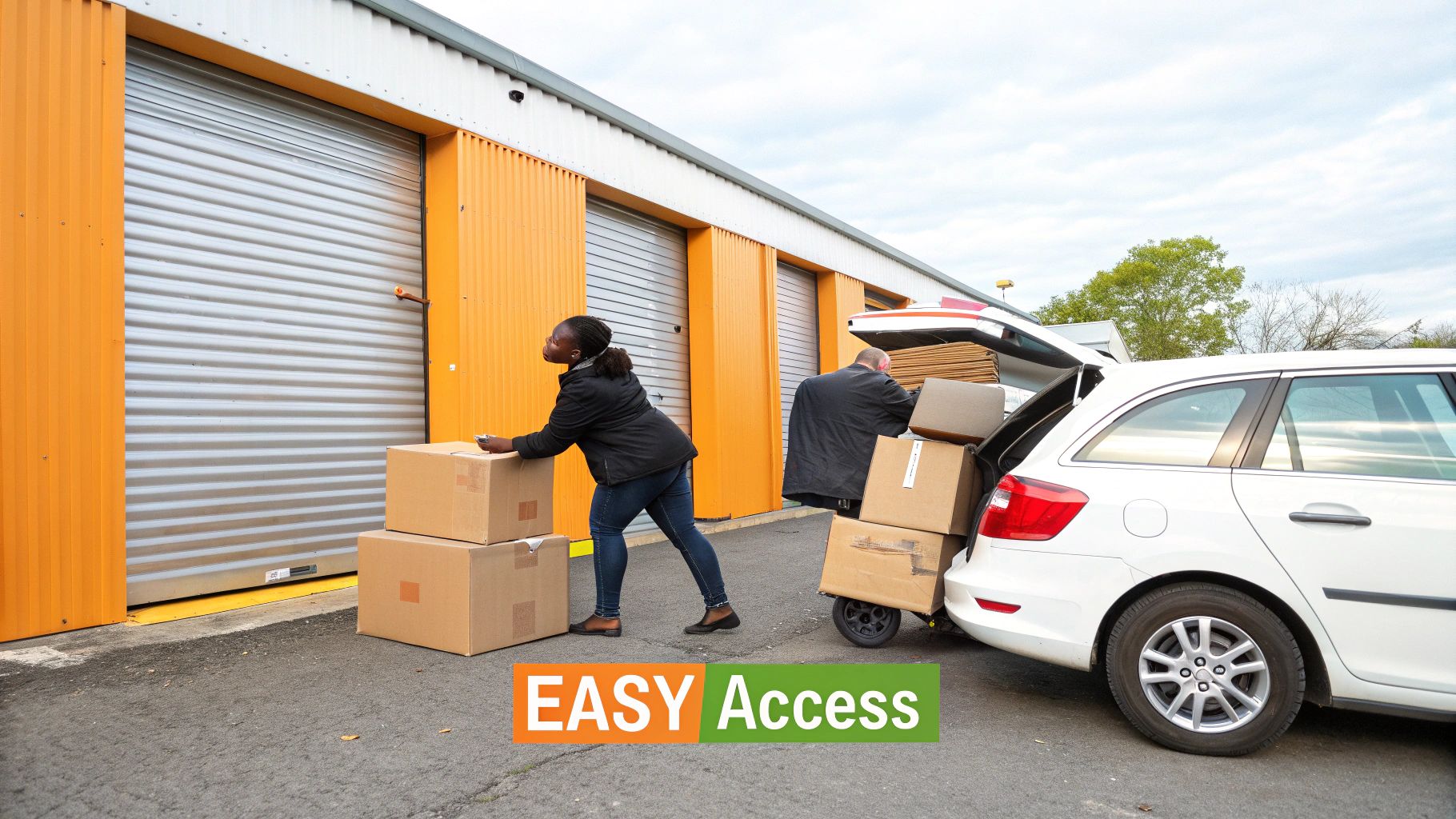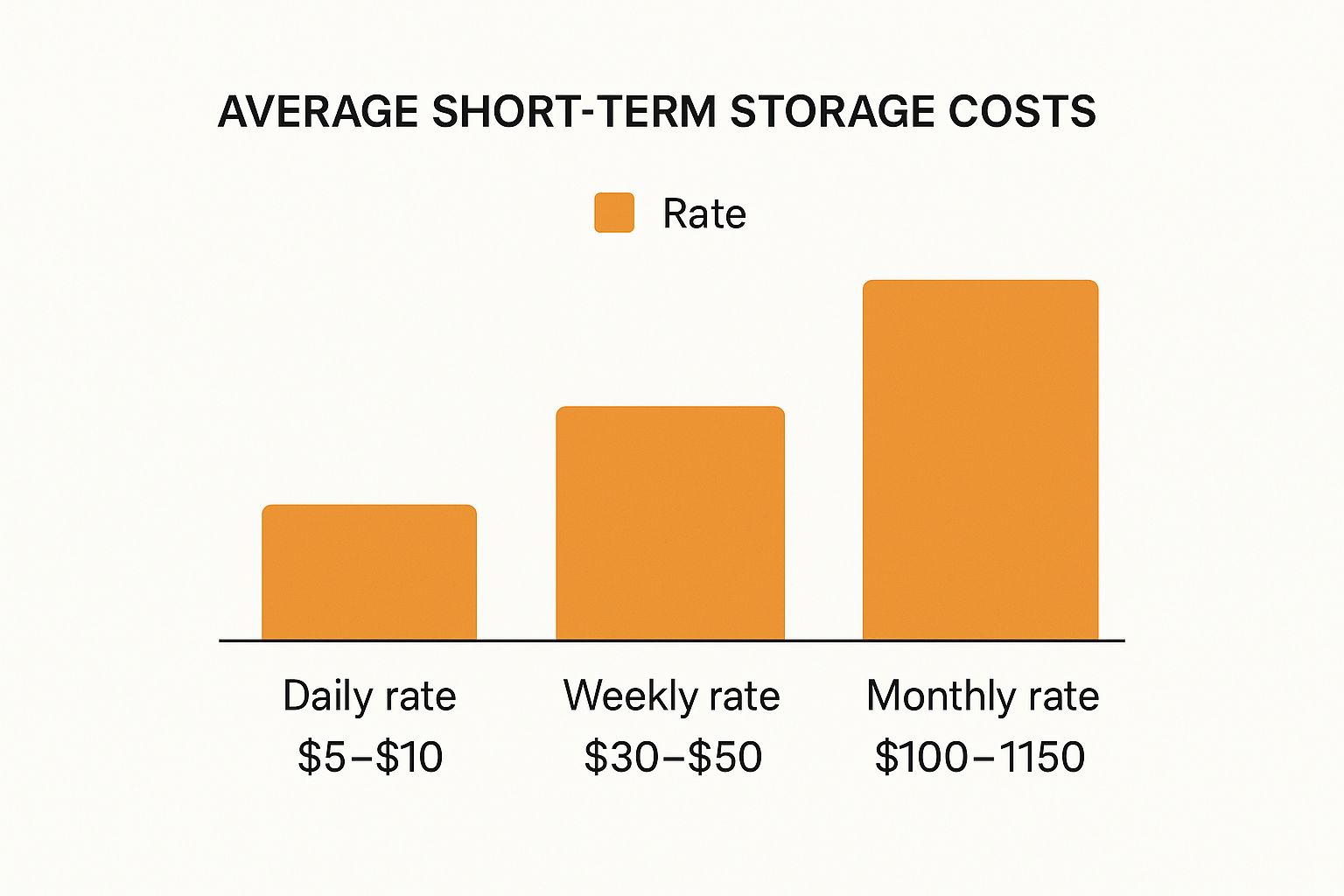So, you need short-term storage. Whether you're in the middle of a messy home renovation, waiting to move into a new place, or just need somewhere to stash business stock for a bit, finding the right unit is key. The trick is to figure out exactly what you need before you start looking. It’s the best way to land a solution that’s practical and doesn’t burn a hole in your pocket.
What to Look For in Short Term Storage
Before you dive into a Google search, take a minute to think about what you actually need from a storage unit. Getting specific is crucial for finding the right fit and avoiding the classic mistake of overspending.
Think about it: a student stashing a few boxes over the summer break has completely different needs from a family storing the contents of a three-bedroom house. While moving house is the big one, accounting for about 50% of storage use, the other half comes from people downsizing, decluttering for a home office, or managing business inventory. Knowing what’s driving demand in your area can give you a better feel for what to expect. You can dig deeper into these UK storage trends to get a clearer picture.
Estimate Your Space Requirements
One of the most common blunders? Paying for a massive, half-empty unit. Or worse, realising mid-move that you’ve run out of room.
Try to visualise all your stuff piled together. A small 25 sq ft unit, which is about the size of a large garden shed, is usually perfect for a student’s belongings – think boxes, a small mattress, and a desk. On the other hand, a 100 sq ft unit is more like a single garage and can comfortably hold the contents of a two-bedroom flat.
To help you get a better sense of what you might need, here's a quick reference guide.
Quick Guide to Choosing Your Storage Unit Size
This table breaks down some of the most common unit sizes and gives you a real-world idea of what they can hold. It's a great starting point for matching your stuff to the right space.
| Unit Size (sq ft) | Equivalent To | Ideal For Storing |
|---|---|---|
| 25 sq ft | Large garden shed | Boxes, small furniture, seasonal gear, student belongings. |
| 50 sq ft | Large walk-in wardrobe | Contents of a studio flat, including a sofa, mattress, and boxes. |
| 75 sq ft | Luton-style van | Furniture and boxes from a one-bedroom flat. |
| 100 sq ft | Single garage | All the contents from a typical two-bedroom flat. |
| 150 sq ft | Garage and a half | Everything from a three-bedroom house, including appliances. |
Remember, this is just a guide. It’s always best to chat with the facility manager if you’re unsure.
Pro Tip: Most facilities have online size estimators, which are incredibly helpful. But if you’re on the fence, it’s always better to go slightly bigger than to find yourself playing a stressful game of Tetris with that last armchair.
Decide if You Need Climate Control
Now, think about what you’re storing. If it’s just garden furniture and old clothes, you probably don’t need anything fancy. But if you’ve got electronics, wooden furniture, artwork, or important documents, the UK's wild temperature swings and humidity can cause some serious damage.
Climate-controlled units keep the temperature and humidity stable, stopping mould, rust, and warping in their tracks. Yes, they cost a little more, but for protecting sensitive or valuable items, it’s a non-negotiable.
Here’s a simple rule of thumb: if you wouldn't feel comfortable leaving it in a shed for a few months, you need climate control. It’s a small investment to make sure your belongings come out looking just as good as they did going in.
Finding the Best Local Storage Facilities
Once you've got a clear checklist of what you need, you can start hunting for the perfect short-term storage with confidence. Most people's first instinct is to jump online, and that’s a great place to begin.
To get the best results, be specific with your search terms. Instead of just typing "storage near me," try something like "climate-controlled storage in Reading" or "student storage Epsom." This simple trick helps cut through the noise and delivers more relevant options right from the start.
Don't just stop at the first few Google results, though. Comparison websites are incredibly helpful for seeing pricing, availability, and features from multiple providers side-by-side. They often collect user reviews too, giving you a quick snapshot of a facility's reputation before you even click over to their website.
Look Beyond the Search Engine
While online tools are powerful, sometimes the best options aren't sitting at the top of the search rankings. A quick drive or even a walk around your target neighbourhood can uncover local, independent facilities that might offer more competitive pricing or a more personal touch.
Don’t forget these old-school (but effective) methods:
- Local Directories: Check business directories specific to your town or region.
- Community Forums: Jump into local Facebook groups or online forums to ask for honest recommendations from your neighbours.
- Word of Mouth: Nothing beats a suggestion from a friend or colleague who has recently moved or renovated.
The UK self-storage industry is surprisingly huge, with 2,915 sites scattered across the country, so you have plenty of choice. Many are making it easier than ever to book, with 90% of facilities now offering online booking. That means you can often secure a unit right from your sofa. You can explore the latest UK self-storage report for more on that trend.
How to Decode Online Reviews
Reviews are your best friend when vetting potential storage spots, but you need to know how to read between the lines. Don’t just glance at the star rating; dig into the comments and look for patterns.
Pay close attention to recent reviews that mention cleanliness, security, and staff helpfulness. A single negative comment might be an outlier, but repeated complaints about billing errors or poor communication are a major red flag.
When you land on a facility's website, look for transparency. Is the pricing clear and upfront? Can you easily find the access hours? Do they proudly display their security features like CCTV and gated access? A professional, easy-to-use website is often a good sign of a well-run business.
By mixing online searches with a bit of real-world investigation, you'll build a solid shortlist of trustworthy candidates for your short-term storage needs.
Time to Compare and Vet Your Shortlist
You've got a handful of promising facilities on your list. Now it's time to look past the glossy websites and dig a little deeper. This is where you separate the good from the truly great and make sure you're getting the best value for your money.
Your first move? Pick up the phone or send a detailed email. A real conversation often reveals more about customer service and transparency than any webpage ever could. Just make sure you go in prepared with a list of specific questions for each facility. This way, you can make a fair, side-by-side comparison later on.
Key Questions to Ask
When you get in touch, zero in on three critical areas: security, access, and the true cost. These are the factors that will ultimately determine your peace of mind and the overall experience.
Here are a few essential questions to get you started:
- Security Measures: "Can you walk me through your security setup? I'm looking for things like 24/7 CCTV, individually alarmed units, and whether you have staff on-site during business hours."
- Access Hours: "What are your standard access hours? Is 24-hour access an option, or are there restrictions? And are there any extra fees for visiting outside of normal hours?"
- Hidden Costs: "Beyond the monthly rental fee, what other charges should I be aware of? I’m thinking of things like admin fees, a mandatory lock purchase, or required insurance costs."
Getting straight answers to these questions now will save you from nasty surprises down the line. Any reputable facility will be completely upfront about all potential charges.
Uncovering the True Cost
That advertised monthly rate is often just the starting point. It’s easy to get caught out by hidden fees for insurance, high-security locks, and one-off administration charges that can seriously inflate the total cost.
This chart gives you a better idea of the typical pricing structures you'll come across.
As you can see, while a monthly rate looks simple, breaking it down helps you figure out if a short-term weekly or even daily rate offers better value for what you need. This is especially important if you only need storage for a few weeks.
The UK self-storage market is booming, with 7.2% more space added in 2024 alone, but demand in city centres is still incredibly high. This growth means more choice for you, but it also makes it vital to compare costs carefully. To get a better handle on market trends, you can read the full UK self-storage industry report.
Facility Comparison Checklist
To make your final decision a bit easier, use a simple checklist to compare your top choices feature-by-feature. It’s a straightforward way to see how each facility stacks up against your personal needs.
| Feature | Facility A | Facility B | Facility C |
|---|---|---|---|
| Monthly Rate | |||
| Admin Fees | |||
| Insurance Cost | |||
| Lock Purchase | |||
| 24/7 CCTV | |||
| On-Site Staff | |||
| Unit Alarms | |||
| 24-Hour Access | |||
| Drive-Up Access | |||
| Customer Reviews | |||
| Proximity | |||
| Total Monthly Cost |
Once you’ve filled this out, the best option should become much clearer, allowing you to book your unit with total confidence.
Securing Your Unit and Understanding the Contract
You’ve found the right facility—congratulations! The last hurdle before you can start moving your things in is the paperwork. It’s always tempting to just skim the rental agreement and sign on the dotted line, but trust me, taking a few extra minutes to actually read it can save you a world of headaches down the road.
This agreement isn't just a formality; it's a legal document spelling out exactly what you and the facility are responsible for. Pay special attention to the clauses on late payment fees and how they handle rent increases. You’ll also want to find the list of prohibited items. Storing things like petrol, paint, or anything perishable is a big no-no and can get your contract terminated on the spot.
Key Clauses to Review Before You Sign
Before you put pen to paper, make sure you’ve double-checked these critical details. They can vary quite a bit from one place to the next and will have a real impact on your experience.
- Notice Period: How much of a heads-up do you need to give before you move out? For short-term rentals, it’s often just 7 to 14 days, but you need to know the exact figure.
- Access Rules: Are there any blackout periods when you can't get to your unit? Some facilities have restricted hours, even if they advertise 24/7 access.
- Insurance Mandate: Most places will insist you have insurance. Find out if you have to buy their policy or if you can use your own home contents cover. It could save you a bit of cash.
It's a common misconception that the facility's insurance covers your belongings. It doesn't. Your insurance is for your items; their insurance is for their building. Always ensure you have adequate cover.
Finally, confirm which payment methods they accept and don’t forget to get a good, sturdy lock. Many facilities sell high-quality disc or cylinder locks right on-site, and they’re far more secure than a standard padlock you’d pick up at a DIY shop. Getting these final details sorted means you can walk in on move-in day feeling confident and ready to go.
How to Pack and Organise Your Storage Unit
You’ve got the unit sorted—now for the final piece of the puzzle: getting everything packed and moved in without a hitch. A smart packing strategy isn't just about cramming everything inside; it's about protecting your belongings and making your life easier when you need to find something later.
First things first, get the right supplies. Using uniform, sturdy boxes is a total game-changer. They stack neatly and securely, letting you use all that vertical space without worrying about a frustrating cardboard avalanche.
Remember to label every single box. Jot down the contents and the room it came from on at least two sides. Trust me, your future self will thank you when you’re hunting for that one specific thing and don't have to tear everything apart to find it.
Strategic Loading for Easy Access
When it’s time to load up the unit, think from back to front. Your heaviest and bulkiest items, like sofas, fridges, and washing machines, should go in first along the back wall. And whenever you can, dismantle furniture like tables and bed frames—it saves a surprising amount of space and prevents scratches.
Pro Tip: Always leave a walkway down the centre of your unit, from the door right to the back. It’s a simple trick, but it means you can actually get to the items at the rear without having to unpack the entire unit first.
Here’s a quick rundown of the packing materials you'll definitely need:
- Sturdy, uniform boxes in a few different sizes.
- Strong packing tape to seal every box up tight.
- Bubble wrap and packing paper for anything fragile, like glassware or electronics.
- Dust covers or old sheets to throw over furniture and protect it from dirt.
A little organisation now goes a long way. It keeps your stuff safe and makes finding what you need a completely stress-free job.
Got Questions About Short-Term Storage?
Even with a solid plan, it's normal to have a few questions rattling around when you're searching for "short-term storage near me". Getting clear answers upfront is the best way to budget properly and dodge common headaches, making sure your rental experience is smooth from day one.
Let's clear up some of the most common queries we hear.
How Much Does Short-Term Storage Cost in the UK?
The price tag on a short-term unit really boils down to three things: size, location, and any special features you might need, like climate control. For a small 25 sq ft locker, which is great for a handful of boxes, you're probably looking at somewhere between £15 and £30 per week. If you need something bigger, say a 100 sq ft unit that can swallow the contents of a two-bedroom flat, the cost could be anywhere from £40 to £70 per week.
Unsurprisingly, prices tend to be higher in big cities like London and Manchester. A word of advice: while many places will tempt you with great introductory offers, always ask what the standard rate will be once that deal expires. Don't forget to factor in the cost of mandatory insurance and a decent lock, too.
Do I Need Special Insurance for My Items?
Yes, you absolutely do. Insurance is almost always a must-have. Storage facilities need assurance that your belongings are protected, and they'll typically offer their own policy for a weekly or monthly fee. This is often the easiest route, giving you instant cover without any hassle.
Before you sign up for the facility's insurance, it's worth checking your existing home contents policy. Some policies actually cover items stored away from home, which could save you a bit of cash. If that's you, you'll just need to show proof of cover to the storage company before moving in.
Whatever you do, don't store your items uninsured. It’s your only safety net against things you can't control, like fire, theft, or water damage.
What Items Am I Not Allowed to Store?
Every facility has a strict list of prohibited items, and it's there for good reason—mainly safety and hygiene. Trying to store anything on this list is a quick way to get your rental agreement terminated on the spot.
As a general rule, you can't store:
- Flammable or hazardous materials: Think petrol, paint, gas canisters, and fireworks.
- Perishable goods: Anything that can spoil and attract pests is a definite no-go.
- Living things: This one’s a given—storing plants or animals is never allowed.
- Illegal or dangerous items: This includes firearms, explosives, and any illegal substances.
Always take a moment to read through the specific restrictions in your rental contract before you start packing. A quick check now can save you a world of trouble on move-in day.
What Is the Minimum Rental Period?
The best thing about short-term storage is its flexibility. Most facilities here in the UK work on a monthly rolling contract. This means you’re not tied down to a long-term commitment you might not need.
While some places might offer weekly rentals, it’s not as common. With a rolling contract, you just need to give notice when you’re ready to move out—usually 7 or 14 days. This setup is ideal for those in-between situations, like moving house, doing a renovation, or handling seasonal stock for a business.
Ready to find a flexible and secure storage solution without the long-term commitment? At Standby Self Storage, you can check prices, book a unit, and move in today. Visit https://www.standbyselfstorage.co.uk to find your perfect space.





